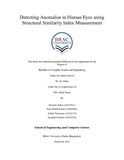Detecting anomalies in human eyes using structural similarity index measurement
Abstract
From the idea of anomaly, we come to learn that basically it is an idea of abnormality of eyesight, and interruption on the screen of eyes that does not fit with the rest of the pattern. Whatever we see or the images we look at are made up of lights reflected from the object we look at. Cornea, lens acquas humor, sclera, retina, choroid, optic nerve each of these components are equally important for eyesight. A slight defect in any part of these components will highly effect to our eyesight. Our main aim is to identify all the eyesight related problems through object detection using image processing. Our target result will be within a range of -1 to1 which will be the structural difference between healthy and unhealthy human eyes. We have identified the problems following two algorithms, one is SSIM and another is Eucledian Distance. In SSIM, we are comparing one healthy eye to another infected eye to distinguish the difference, by which we suggest the detected anomaly to the user. In Eucledian Distance, we are measuring the size of the IRIS to detect eye anomalies like myopia and lazy eye. From our results, we got the values between our expected ranges with slight error margining.

